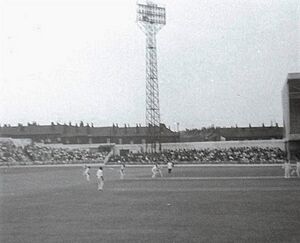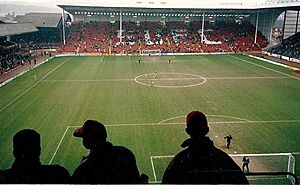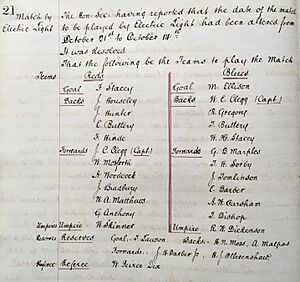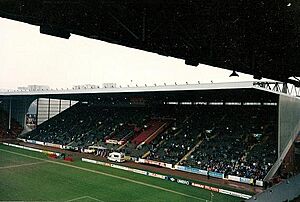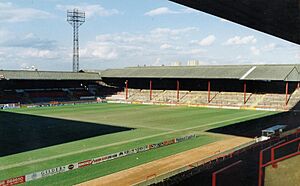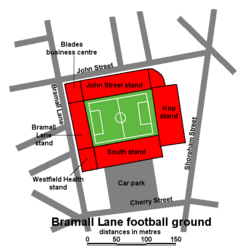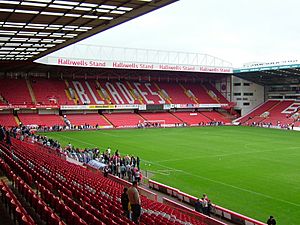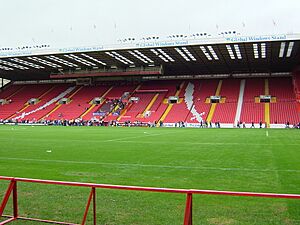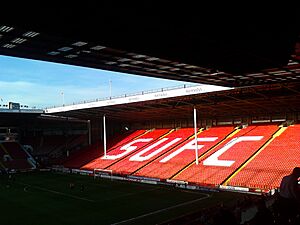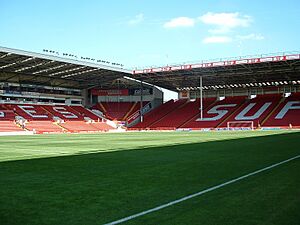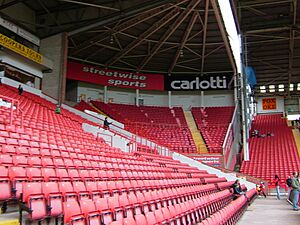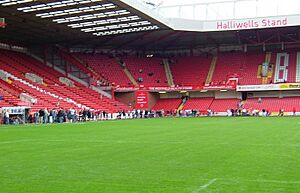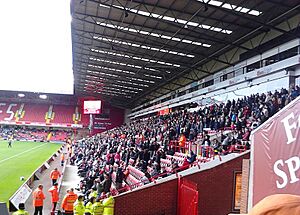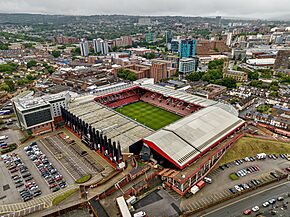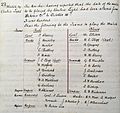Bramall Lane facts for kids

Bramall Lane in 2023
|
|
| Full name | Bramall Lane Stadium |
|---|---|
| Location | Highfield, Sheffield England S2 4SU |
| Coordinates | 53°22′13″N 1°28′15″W / 53.37028°N 1.47083°W |
| Public transit | |
| Owner | Sheffield United |
| Capacity | 32,050 |
| Field size | 101 by 68 metres (110.5 by 74.4 yd) |
| Surface | Desso GrassMaster |
| Construction | |
| Broke ground | 1855 |
| Opened | 30 April 1855 |
| Renovated | 1966 (Bramall Lane Stand built) 1975 (South Stand built) 1991 (Kop seated) 1994 (all-seated) 1996 (John St Stand rebuilt) 2006 (concourses in Bramall Lane Stand redeveloped) |
| Expanded | 2001 (Kop Corner built) 2006 (Westfield Health Stand built) |
| Architect | (John St Stand) Ward McHugh Associates |
| Tenants | |
|
|
| Ground information | |
| International information | |
| Only Test | 3 July 1902: |
| As of 1 January 2017 Source: Cricinfo |
|
Bramall Lane is a famous football stadium in Sheffield, England. It is the home ground for Sheffield United.
This stadium has a long and interesting history. It started as a cricket ground in 1855. The stadium is named after the Bramall family, who owned businesses nearby.
In the 1800s, Bramall Lane was the biggest stadium in Sheffield. It hosted many important matches. These included the final of the world's first football tournament, the first floodlit match, and games that helped create unified football rules.
Teams like The Wednesday F.C. (now Sheffield Wednesday) and Sheffield F.C. also used the ground. Since 1889, it has been the home of Sheffield United. It is the oldest major stadium in the world that still hosts professional football games.
Bramall Lane is one of only two grounds to have hosted an England international football match, an England Test cricket match, and an FA Cup Final. It also hosted UEFA Women's Euro 2022 matches, including a semi-final.
The stadium has also been used for other events. These include rugby league games, concerts by famous musicians, and boxing matches.
The highest number of people ever to watch a game here was 68,287 in 1936. After big changes, the stadium now has seats for 32,050 fans.
Contents
History of Bramall Lane
Early Days as a Cricket Ground
Bramall Lane first opened as a cricket ground in 1855. Michael Ellison rented the land from the Duke of Norfolk. It was a good spot because it was away from the city's smoky factories.
The ground was built for local cricket clubs. One of these was The Wednesday Cricket Club, which later became Sheffield Wednesday Football Club.
The first cricket match was played on April 30, 1855. A team from Yorkshire played its first county match here in August 1855.
Bramall Lane was the main home for Yorkshire County Cricket Club until 1893. Many important cricket matches were played here.
In 1902, Bramall Lane hosted one Test match between England and Australia. England lost this match. People thought the poor light from nearby factories was a problem. Because of this, no more Test matches were played here.
Yorkshire played its last cricket match at Bramall Lane in August 1973. Soon after, construction began on the South Stand, covering the cricket area. Yorkshire's cricket games then moved to another ground.
Football Arrives at Bramall Lane
The first football match at Bramall Lane was on December 29, 1862. It was between Sheffield and Hallam. The game was played to raise money for people in need.
As Sheffield's main sports stadium, it hosted many important local football games. This included the final of the 1867 Youdan Cup. A new team called The Wednesday won the Cromwell Cup here a year later.
Bramall Lane became The Wednesday's regular home from 1880 until 1887.
The first match between different football associations was also held here. The FA played against the Sheffield FA on December 2, 1871.
On March 22, 1889, a new football team was created to play at Bramall Lane. This team was named Sheffield United, after the cricket team.
International Football Matches
Bramall Lane hosted many international football matches before a national stadium was built in London. The world's first ever floodlit football match took place here on October 14, 1878. Over 20,000 people watched.
England played Scotland here on March 10, 1883. This was the first match between these two countries outside of London or Glasgow. Bramall Lane is the second-oldest football stadium in the world that can still host international games.
| Date | Result | Competition | ||
|---|---|---|---|---|
| 4 October 1883 | 2–3 | Friendly (men) | ||
| 5 February 1887 | 7–0 | British Home Championship | ||
| 29 April 1889 | 4–0 | British Home Championship | ||
| 4 April 1903 | 1–2 | British Home Championship | ||
| 20 October 1930 | 5–1 | British Home Championship | ||
| 7 April 1990 | 1–0 | Euro 1991 qualifying group stage | ||
| 9 March 1997 | 6–0 | Friendly (women) | ||
| 3 December 2024 | 1–0 | Friendly (women) |
UEFA Women's Euro 2022 Matches
Bramall Lane was one of the stadiums used for the UEFA Women's Euro 2022 tournament. It hosted several group stage matches. It also hosted a semi-final game, which featured England.
| Date | Home | Away | Result | Attendance | Stage |
|---|---|---|---|---|---|
| 9 July 2022 | 1–1 | 21,342 | UEFA Women's Euro 2022 Group B | ||
| 13 July 2022 | 2–1 | 12,914 | UEFA Women's Euro 2022 Group B | ||
| 17 July 2022 | 1–4 | 22,596 | UEFA Women's Euro 2022 Group B | ||
| 26 July 2022 | 4–0 | 28,624 | UEFA Women's Euro 2022 Semi Final |
Key Moments in Stadium History
- 1855: The ground at Bramall Lane was built for cricket.
- 1878: The first floodlit football game was played here.
- 1889: Sheffield United Football Club was founded.
- 1896: A new John Street Stand was built.
- 1901: The old cycle track was removed.
- 1935: A roof was added to the Kop stand.
- 1940: The stadium was damaged during the Sheffield Blitz in World War II.
- 1953: Floodlights were installed for night games.
- 1966: The Bramall Lane Stand opened.
- 1975: The South Stand opened.
- 1991: Seats were added to the Kop stand.
- 1994: Bramall Lane became an all-seater stadium.
- 1996: A new John Street Stand opened.
- 2001: A new corner stand was built between Shoreham Street and John Street.
- 2002: The Blades Enterprise Centre, with offices, was built.
- 2006: A new corner stand opened between Cherry Street and Bramall Lane.
- 2008: A new hotel was built next to the stadium.
- 2015: A modern Desso pitch was installed, replacing the traditional grass.
Bramall Lane Today
Since 1994, Bramall Lane has been an all-seater stadium. It has four main stands and two corner sections. The north-west corner has the Blades Enterprise Centre. A four-star hotel is located in the south-west corner.
The Stands of Bramall Lane
Bramall Lane Stand
This is the oldest stand still standing at Bramall Lane. It opened in 1966. The lower part is usually for visiting fans. The upper part is for home fans.
In 2006, the outside of the stand was updated with red and white colors. The old wooden seats were replaced with new plastic ones that spell "BLADES". A modern video scoreboard was also added.
This stand can hold about 5,680 fans. It was briefly called the "Jessica Ennis Stand" after the 2012 Olympics.
The Tony Currie Stand (South Stand)
This stand opened in 1975. In 2018, it was named after Sheffield United legend Tony Currie. Many older fans still call it the "New Stand" because there was no stand here before 1975.
The South Stand was also updated in 2006. It now has red and white seats that form an emblem of two swords. This stand holds about 7,500 fans. It also has many of the stadium's important facilities. These include the ticket office, club shop, and the "Legends of the Lane" museum.
Outside the stand, there is a "Wall of Fame" made of red bricks. Each brick has a supporter's name on it. Statues of club legends Joe Shaw and Derek Dooley are in the car park.
The Kop Stand
The Kop Stand has had seats since 1991. This is where the most enthusiastic home fans sit. The noise from this stand is sometimes called the "Bramall Roar".
The stand is built into a hillside along Shoreham Street. It has the club's initials "SUFC" written in the seats. It can hold 10,221 fans, making it the largest stand at Bramall Lane. Even though the facilities are simpler, it's a very popular spot for fans.
John Street Stand
The John Street Stand is for home fans and families. It is along the north side of the pitch. This stand was finished in 1966.
It has the word "BLADES" written in the seats and holds almost 7,000 fans. This stand also has wheelchair spaces and 31 executive boxes. These boxes offer special hospitality for match days.
John Street Corner
This corner stand was completed in 2001. It is located between the Kop and the John Street Stand. It is also used for families and holds about 900 fans. This area was once part of the Kop stand.
Bramall Lane Corner
This "new" corner stand is in the south-west part of the stadium. It is between the Bramall Lane Stand and the South Stand. It is connected to the Bramall Lane Stand and is used by home fans. Many people say it has the best views of the pitch. This stand holds about 2,000 fans. A four-star hotel is built right behind it.
Blades Enterprise Centre
The north-west corner of the stadium has offices called the Blades Enterprise Centre. This center offers office space for small and new companies. It helps Sheffield United earn extra money. It was completed in 2002.
Stadium Hotel
A 158-room, 4-star hotel was built next to the stadium in 2008. It was first a Millennium and Copthorne Hotel. It closed in 2020 but reopened in August 2024 as a DoubleTree by Hilton hotel. This hotel helps the stadium make more money.
Future Plans for Bramall Lane
The club has plans to make the stadium even bigger. They want to add about 3,200 seats to the Kop stand. This would make the Kop hold around 13,400 fans.
There are also plans to improve the facilities in the Kop. The club has thought about adding 6,000 more seats to the South Stand. This would bring the stadium's total capacity to over 44,000. However, these plans depend on the club's success and other factors.
New ideas for the open corner between the Kop and South Stand were shared in 2017. These plans include building residential flats and a larger club shop.
Stadium Attendance Records
The highest number of people ever to attend a game at Bramall Lane was 68,287. This was for an FA Cup match between Sheffield United and Leeds United on February 15, 1936.
Since 1994, when all seats were installed, the record attendance is 32,604. This was for a Premier League game between Sheffield United and Wigan Athletic on May 13, 2007.
Sheffield United often has high attendance numbers. In the 2007–2008 season, they had the best average attendance in the Championship league.
Average League Attendances
- These are the average numbers of fans at Sheffield United's home league matches at Bramall Lane since the 2009–10 season.
- 2009–2010: 25,120
- 2010–2011: 20,632
- 2011–2012: 18,702
- 2012–2013: 18,612
- 2013–2014: 17,507
- 2014–2015: 19,805
- 2015–2016: 19,803
- 2016–2017: 21,892
- 2017–2018: 26,854
- 2018–2019: 26,175
- 2019–2020: 24,370
Getting to Bramall Lane
Bramall Lane is in the Highfield area, just south of Sheffield city center. It's easy to find from the A61 road that goes around the city center.
On match days, Bramall Lane road is closed to most traffic. This helps keep people safe and allows team buses to get to the stadium easily.
Public Transport Options
Sheffield station (for trains and trams) and Sheffield Interchange (for buses and coaches) are less than a mile from the stadium.
Sheffield's light rail tram system, called the Supertram, runs east of the ground. The nearest tram stops are Granville Road/The Sheffield College and Park Grange Croft. Both stops are about half a mile away. The Blue and Purple tram routes serve these stops.
There are also bus stops on Shoreham Street and Bramall Lane. Other nearby bus stops are on Charlotte Road, Queens Road, and London Road. All these buses go to and from the city center.
Cycling to the Stadium
The stadium is close to Route 6 of the National Cycle Network. There are many cycle paths and lanes around the stadium. The Bramall Lane roundabout has an underpass for cyclists and walkers. Bramall Lane itself has a cycle lane. There are places to park bikes near the ground.
Images for kids
-
The John Street Stand before a Championship game v. Coventry City in 2010
See also
 In Spanish: Bramall Lane para niños
In Spanish: Bramall Lane para niños


